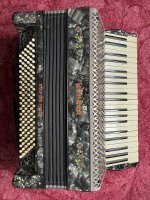Hello!
I'm hoping someone can help me with any information and perhaps an idea of value on my late grandmothers accordion, a Hohner Supremus.
I've contacted Hohner direct and I've been told it is model number 150/41/120/3 in the colour black-perloid, produced in the 1930's. They have also provided the serial number which is useful. But i still don't know much else about it. I've tried searching for this model online, and on places like eBay but haven't had much luck. I'm planning on selling it so it would be great to know if it was a common model or a bit rarer, and any tips on its potential value.
The accordion itself was very well looked after by my grandma so i am assuming it works fine with no issues. Its been stored away in its case for about 30-40 years, untouched.
I am absolutely clueless about accordions so any information would be much appreciated. Thank you!

I'm hoping someone can help me with any information and perhaps an idea of value on my late grandmothers accordion, a Hohner Supremus.
I've contacted Hohner direct and I've been told it is model number 150/41/120/3 in the colour black-perloid, produced in the 1930's. They have also provided the serial number which is useful. But i still don't know much else about it. I've tried searching for this model online, and on places like eBay but haven't had much luck. I'm planning on selling it so it would be great to know if it was a common model or a bit rarer, and any tips on its potential value.
The accordion itself was very well looked after by my grandma so i am assuming it works fine with no issues. Its been stored away in its case for about 30-40 years, untouched.
I am absolutely clueless about accordions so any information would be much appreciated. Thank you!

